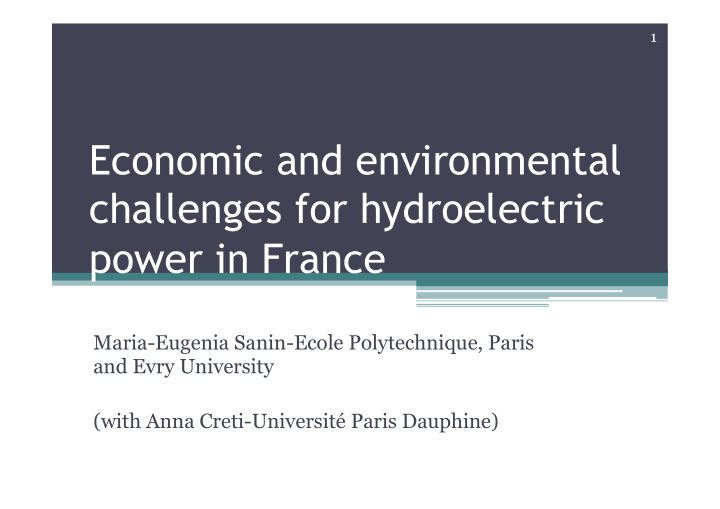



1 Economic and environmental challenges for hydroelectric power in France Maria-Eugenia Sanin-Ecole Polytechnique, Paris and Evry University (with Anna Creti-Université Paris Dauphine)
2 Outline Objective of the talk: illustrate the incompleteness of the opening to competition of hydroelectric concessions in France and the criteria that shall be used (quite different from Italy) 1. Importance of hydro capacity and production in France 2. Opening to competition: ▫ First steps: 2010-2012 ▫ Lastest proceedings: 2012 to present 3. Case study: environnmental versus rent sharing criteria ▫ Evaluation of the environnmental quality in the Gave d’Aspe (Vallée d’Ossau) 4. Challenges for the future organization of the hydroelectric sector
3 Hydroelectric capacity and production in France
4 Share of hydroelectric production among primary energy sources Rather constant share of the hydro production over more than 40 years Source : Ministère du Dév Durable (2014), Bilan Energétique Français 2012
5 Share of hydroelectric production among renewables Source: Ministère du Dév Durable (2014), Chiffres clé des Energies Renouvelables
6 Production In 2013 production was of 75.7 TWh , out of 550.9 TWh of total French production (403.7 TWh nuclear).
7 Capacity and Geographical Location Total installed capacity in 2012: 25 GW that is 25 % electric installations connected to the high voltage grid
8 Different Technologies Average age of hydroelectric installations: 50 years 75 % more than 24 years; 50 % more than 44 years; 25 % more than 74 years.
9 Market players In 2014 EDF owns 640 dams and 439 hydroelectric plants The Société hydroélectrique du Midi (Shem)- acquired by GdF-Suez exploits 12 dams and 56 hydroelectric plants in the Pyrénées region « 2002-2006 : Electrabel (groupe SUEZ) conclut un accord de partenariat capitalistique et commercial avec la SNCF et entre progressivement au capital de la SHEM, jusqu’à la contrôler à 99,6% »
10 National initiatives Law Grenelle (2010): +3GW and +3Twh of production by 2020 Union Française des Electriciens (2011): unexploited potential of 10.6TWh i.e. 16% of the actual annual hydroelectric production +9.5 TWh/year from new installations +1.1 TWh/year from repowering installed capacty
11 Opening to competition
12 Opening to competition: first steps • First opening was scheduled in 2010 to take place by the end of 2012 • Ecology Minister JL Borloo starts the procedure in april 2010 regrouping (by basin) 50 sites in 10 concessions to be opened by 2015.
13 The « basin » criterion Concessions in the Alps (Vallée du Drac, chaîne du Beaufortain, Bissorte), the Pyrénées (Vallées d'Ossau, du Louron et de la Têt) and Massif Central (Vallée de la Dordogne et de la Truyère) were supposed to open to competition between 2013 and 2015, representing 2.800 MW. To grant the « basin criterion » about 15 concession (2.300 MW) were supposed to be interrupted earlier than their planned end.
14 The concessions targeted to the opening
15 « Dossier des concessions » ▫ 3 criteria: • Economic efficiency: candidates are expected to significantly improve the existing infrastructures in order to increase (if possible) the production and peak capacity; • Environmental impact: within each project, petitioners have to show their actions to reduce their environmental impact; • Revenue sharing: candidates are expected to present a financial business plan in which they show the expected revenues and a revenue sharing percentage (to be equally divided among the State and Local Authorities). Around 25-30%?
16 • Additional Criteria: ▫ New entrants must: � compensate for early concession interruption (if any) � contribute to territorial planning � limit employment reduction/change
17 Latest proceedings: 2012… • February 2012: the Direction Général Energie et Climat (DGEC) organises a workshop with potential petitioners ▫ the procedure is foreseen after the presidential election • April 2012: four consulting firms selected to assist the DGEC in assessing the concession opening (technical, legal, financial and organisational aspects covered) • October 2012: Minstry of Ecology D. Batho delays the procedure, being against the opening to competition
18 …to present • The political uncertainty disrupts the process ▫ The new entrant Force Hydro (Vattenfall, SNCF, Solvay, ArcelorMittal), contending 10 concessions, breaks up • The 14th of May the new Minister S. Royal announces being against the opening to competition but she must convince Brussels…
19 Case study: environnmental versus rent sharing criteria
20 Are these criteria equally important? • Creti, Pontoni (2014) has conducted a choice experiment in the Gave d’Aspe-Vallée d’Ossau, Southwest Pyrenées. ▫ On the Aspe river there are 16 hydropower plants, for a total of 93 MW, of which 63 MW are run-of- the-river plants • According to the results, the highest total willingness to pay (WTP) for the river protection is Hydroelectric concession above 144 € /year bidders should give priority to environmental aspects • Marginal WTP for a satisfactory fish stock reaches 250 € /year
21 Conclusions • Critical points: • EdF dominance • Lack of political willingness to enforce the European law • « The winner takes all » strategy: environnmental protection? capacity expansion?
Recommend
More recommend